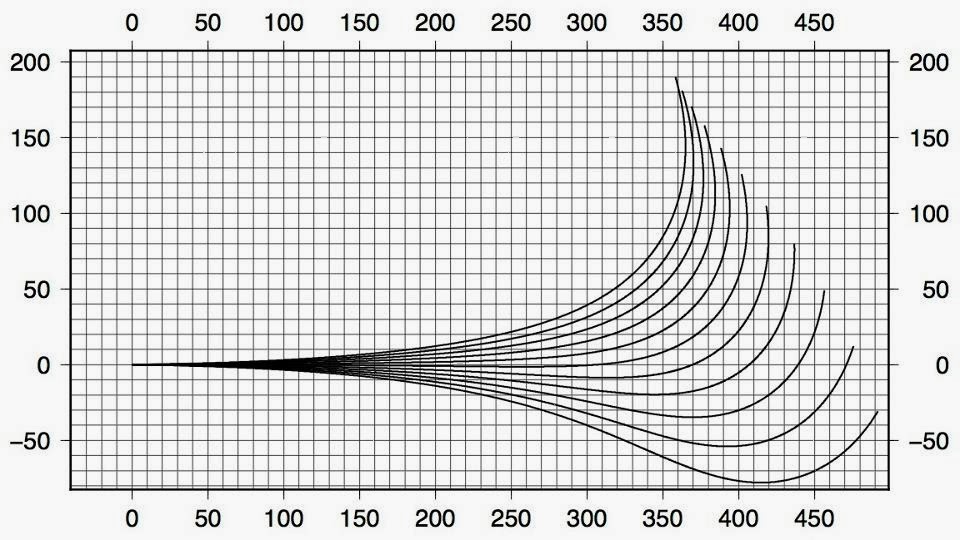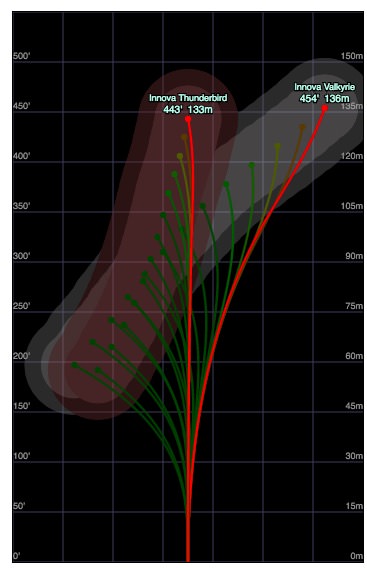Thesis Statement:
When throwing at a target that does not require some form of flex or anhyzer, an overstable disc (teebird, thunderbird, etc) is almost always preferred to an understable disc (leopard3, valkyrie, etc).
Why:
Take a 300 ft throw with a valkyrie (a disc I throw a good deal), and a thunderbird. With the same release angle, velocity, etc, the valkyrie will fly straight/turn slightly, then finish left. The thunderbird will fly straight, then finish left (rhbh). Now imagine they both are thrown such that they land at the exact same spot.
Now increase the power behind each throw by 10%. The thunderbird will fly 330 ft, but still finish about on the same line as the previous point, ending up ~ 30 ft from the original spot. The Valkyrie, on the other hand, will turn more to the right before fading, ending up both 30 feet beyond the previous point and an additional distance to the right due to the fade.
The same phenomenon can be applied to release angle - if both are released more on an anhyzer on the second shot, the valkyrie will still end up further away from the previous point.
All in all, overstable discs provide the most consistent accuracy due to fact that overstable discs are less susceptible to both velocity and angle release errors by the thrower.
Now don't get me wrong - I'm not advocating throwing all overstables discs all of the time, or even learning disc golf with an overstable disc. I learned distance driving with a valkyrie, and I find it to be a highly versatile disc. However, it also tends to be a "touchier" disc - too much power and the disc will straighten out and fly too far past/right of the basket. An overthrown Teebird will just end up a little beyond the basket.
TLDR: Overstable discs are the preferred (tournament?) choice for many/most shot selections due to their ability to mitigate velocity and angle errors, providing the most consistent results.
When throwing at a target that does not require some form of flex or anhyzer, an overstable disc (teebird, thunderbird, etc) is almost always preferred to an understable disc (leopard3, valkyrie, etc).
Why:
Take a 300 ft throw with a valkyrie (a disc I throw a good deal), and a thunderbird. With the same release angle, velocity, etc, the valkyrie will fly straight/turn slightly, then finish left. The thunderbird will fly straight, then finish left (rhbh). Now imagine they both are thrown such that they land at the exact same spot.
Now increase the power behind each throw by 10%. The thunderbird will fly 330 ft, but still finish about on the same line as the previous point, ending up ~ 30 ft from the original spot. The Valkyrie, on the other hand, will turn more to the right before fading, ending up both 30 feet beyond the previous point and an additional distance to the right due to the fade.
The same phenomenon can be applied to release angle - if both are released more on an anhyzer on the second shot, the valkyrie will still end up further away from the previous point.
All in all, overstable discs provide the most consistent accuracy due to fact that overstable discs are less susceptible to both velocity and angle release errors by the thrower.
Now don't get me wrong - I'm not advocating throwing all overstables discs all of the time, or even learning disc golf with an overstable disc. I learned distance driving with a valkyrie, and I find it to be a highly versatile disc. However, it also tends to be a "touchier" disc - too much power and the disc will straighten out and fly too far past/right of the basket. An overthrown Teebird will just end up a little beyond the basket.
TLDR: Overstable discs are the preferred (tournament?) choice for many/most shot selections due to their ability to mitigate velocity and angle errors, providing the most consistent results.

